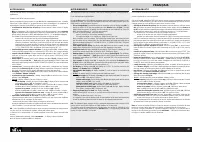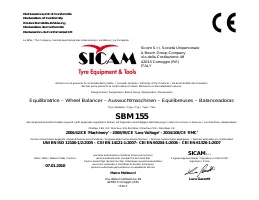Solo 155 Desbrozadora – Manual de instrucciones en formato pdf, léalo en línea gratis. Esperamos que le ayude a resolver cualquier duda que pueda tener al utilizar el aparato.
Si aún tiene preguntas, escríbalas debajo del manual de instrucciones.
"Estamos cargando el manual" significa que debe esperar a que se cargue el archivo para poder leerlo en línea. Algunos manuales son muy pesados y el tiempo que tardan en aparecer depende de su velocidad de internet.

ITALIANO
ENGLISH
FRANÇAIS
38
COD. 655632 Rev.0
CONTROLLO EQUILIBRATURA
Sono neccessari due metodi di prova per assicurarsi che l’equilibratura avvenga in modo perfetto.
PROVA DI BUON FUNZIONAMENTO DELLA BILANCIATURA
» Si equilibrano sulla macchina i due lati della ruota, seguendo le istruzioni.
» Quindi si produce artificialmente uno squilibrio, applicando un peso di 50 grammi su uno dei due
lati. La macchina deve indicare esattamente questo squilibrio, sia l’entità che la posizione,
mentre può esservi un’indicazione massima di 5 grammi per l’altro lato.
» Per controllare la posizione dello squilibrio si gira la ruota sulla posizione di squilibrio indicata
dalla macchina tramite l’indicazione delle frecce sul monitor (ore 6). In tale posizione, il peso di
prova applicato deve trovarsi verticalmente sotto l’asse di rotazione (ore 6).
» Se vi sono delle deviazioni angolari chiaramente visibili, occorre rettificare l’indicazione ripetendo
la taratura.
» Se si verificano deviazioni inaccettabili sull’entità di squilibrio indicato, per il lato della ruota
dove è applicato il peso di prova, oppure c’è un’indicazione eccessiva sull’altro lato della ruota,
bisogna ritarare la macchina.
PRECISIONE DI CENTRATURA (Qualità di Equilibratura)
» A tal scopo si può impiegare la ruota già equilibrata nella prova precedente. Togliere il peso di
prova. Quindi sbloccare la ruota dall’attrezzo adattatore e ribloccarla, ma spostata di circa 35°.
» In un lancio di prova, l’indicazione non deve superare un massimo squilibrio di 10 grammi su
ogni lato (15g. in caso di ruote particolarmente pesanti). Questo errore è dovuto alle tolleranze
nella centratura del cerchio.
» Una centratura precisa è essenziale sia per questa prova che nella normale procedura di
equilibratura. Se in questo lancio di prova si rileva uno squilibrio elevato, bisogna controllare
l’usura, i giochi e la sporcizia delle parti impiegate per centrare la ruota.
TARATURA CALIBRI AUTOMATICI *
* In funzione del modello la macchina è dotata di questo dispositivo.
Si può accedere alla taratura del calibro automatico dopo aver effettuato la prima fase di taratura o
tramite il tasto MENU’ all’interno del menu di taratura.
Sul display di sinistra comparirà d-1;
- Portare il cursore B millimetrato della distanza in posizione di riposo; impostare sulla tastiera
il numero letto sull’asta millimetrata tramite i tasti 10 di fig.18:
Il dato impostato comparirà sul display di destra; assicurarsi che il cursone B sia nella posizione
di riposo e premere il tasto”OK”.
Sul display di sinistra comparirà d-2.
- Portare il cursore B millimetrato in massima apertura, impostare sulla tastiera il valore letto
tenendolo in quella posizione e premere il tasto “OK”; quindi riportarlo nella posizione di riposo.
Sul display di sinistra comparirà L-1.(larghezza)
- Portare il cursore A nella massima apertura, misurare la distanza (con il metro) fra il cursore
millimetrato ed il cursore esterno (ved. fig. 24) nei punti di battuta tenendoli allineati. Impostare
il valore misurato (in millimetri) sulla tastiera; arrestando il tastatore in questa posizione premere
“ O K ” .
Sul display di sinistra comparirà L-2.
- Portare il cursore esterno A in minima apertura e, tenendoli allineati, misurare la distanza tra i due
punti di battuta; impostare la misura sulla tastiera e sul display di destra comparirà il dato;
arrestando il tastatore in questa posizione premere “OK”.
Sul display di sinistra comparirà h-1 (altezza).
- Montare una ruota possibilmente 13"-14"; portare il cursore millimetrato con il punto di battuta
sul cerchio (ved. fig.25). Impostare sulla tastiera l’altezza in pollici della ruota montata sulla
macchina e, tenendola ferma nella posizione, premere “OK”.
Sul display di sinistra comparirà C-2 per eventualmente fare la seconda fase di taratura (auto-
taratura equilibratrice).
La taratura viene automaticamente memorizzata.
N.B: ogni tacca = 1 mm
BALANCING CHECK
Two test procedures are necessary to ensure that wheel balancing is conducted accurately.
BALANCING ACCURACY TEST
» Balance the two sides of a wheel according to the instructions.
» Artificially create an imbalance by fitting a weight of 50 grams on one side of the wheel. The
machine should identify this imbalance precisely, both for weight and position. A reading up to
a maximum of 5 g is possible for the other side.
» In order to check the position of the imbalance, turn the wheel to the balancing position as
indicated by the arrows on the monitor (6 o’clock). In this position the test weight should be
vertically below the rotation axle (6 o’clock).
» If there is an obvious angular error the indicators have to be rectified.
» If there is an unacceptably big weight error on the side with the test weight, or an excessive figure
for the opposite side of the wheel, the machine has to be recalibrated.
CENTRING PRECISION (Balancing Quality)
» The wheel balanced in the previous test can be used. Remove the test weight. Release the
wheel from the adapter and retighten it, but rotated by about 35°.
» In a test cycle the imbalance must not exceed a maximum of 10 g on each side (15 g in the case
of particularly heavy wheels). This error is due to the rim centring tolerance.
» Precise centring is essential both for this test and during normal balancing operations. If this test
run produces a high imbalance reading check the parts used for centring the wheel for wear, play,
and dirt.
CALIBRATING THE AUTOMATIC GAUGES *
* The presence of this device depends on the machine model.
The calibration of the automatic gauges can be accessed after carrying out the first calibration
procedure or using the MENU button in the calibration menu.
The left display reads d-1;
- Move the millimeter scale distance cursor B to its retracted position. Set the number read on the
millimeter scale with the buttons 10 of fig.18.
The figure appears on the right display. Check that the cursor is in its retracted position and press
the “OK” button.
The left display reads d-2.
- Move the millimeter scale cursor B to its maximum extension and, keeping it in that position,
set the reading with the buttons then press the “OK” button. Now move it back to its retracted
position.
The left display reads L-1.(width)
- Move cursor A to its maximum extension, measure the distance (with the ruler) between the stop
surfaces of the millimeter scale cursor and the external cursor (see fig. 24), keeping them aligned.
Set the measurement (in millimeters) with the buttons and, keeping the gauge probes in this
position, press “OK”.
The left display reads L-2.
- Move the outside cursor A to its minimum aperture and, keeping them aligned, measure the
distance between the two stop surfaces. Set the measurement with the buttons, the right display
shows the figure. Keeping the gauge probe in this position, press “OK”.
The left display reads h-1 (height).
- Mount a wheel, ideally of 13"-14". Move the millimeter scale cursor until it comes into contact
with the rim (see fig.25). Set the height of the mounted wheel in inches and, keeping it in position,
press “O K”.
The left display reads C-2 for the second calibration phase if required (balancing machine self-
calibration).
The calibration settings are automatically saved.
N.B: each notch = 1 mm
CONTROLE D’EQUILIBRAGE
Deux méthodes d’essai sont nécessaires pour s’assurer que l’étalonnage ait lieu parfaitement.
ESSAI DU BON FONCTIONNEMENT DE L’EQUILIBRAGE
» On équilibre les deux côtés de la roue sur la machine, en suivant les instructions.
» Ensuite on produit un balourd artificiel, en appliquant une masse de 50 grammes sur l’un des
deux côtés. La machine doit indiquer exactement ce balourd, son ampleur et la position, alors
qu’il peut y avoir une indication de 5 grammes maximum pour l’autre côté.
» Pour contrôler la position du balourd on tourne la roue sur la position de balourd indiquée par la
machine par les flèches sur le moniteur (6 h). Dans cette position, la masse d’essai appliquée
doit se trouver verticalement sous l’axe de rotation (6 h).
» S’il existe des déviations angulaires clairement visibles, il faut rectifier l’indication.
» Si des déviations inacceptables sur l’ampleur du balourd indiqué se produisent sur le côté de
la roue où la masse d’essai est appliquée, ou s’il y a une indication excessive sur l’autre côté
de la roue, il faut étalonner la machine à nouveau.
PRECISION DE CENTRAGE (Qualité d’équilibrage)
» Il est possible d’utiliser la roue déjà équilibrée pendant l’essai précédent. Ôter la masse d’essai.
Ensuite débloquer la roue de l’adaptateur et la rebloquer, déplacée d’environ 35°.
» Pendant un lancer d’essai, l’indication ne doit jamais excéder un balourd maximum de 10
grammes de chaque côté (15 g. dans le cas de roues particulièrement lourdes). Cette erreur est
due aux tolérances au cours du centrage de la jante.
» Un centrage précis est essentiel aussi bien pour cet essai que pour la procédure d’équilibrage
normale. Si pendant ce lancer d’essai on a un balourd élevé, il faut contrôler l’usure, les jeux et
la saleté des parties utilisées pour centrer la roue.
ETALONNAGE DES PIGES AUTOMATIQUES *
* La machine est munie de ce dispositif, selon le modèle.
Il est possible d’accéder à l’étalonnage de la pige automatique après avoir effectué la première
phase de tarage ou par la touche MENU à l’intérieur du menu de tarage.
Sue le moniteur à gauche apparaîtra d-1;
- Amener le curseur millimétré de la distance B à la position de repos; introduire au clavier le
numéro lu sur la tige millimétrée en tapant la touche 10 de fig.18:
Le donnée introduite apparaîtra sur le moniteur à droite; s’assurer que le curseur B soit à la
position de repos et presser la touche”OK”.
Sur le moniteur à gauche apparaîtra d-2.
- Amener le curseur millimétré B au maximum de l’ouverture, introduire au clavier la valeur lue en
le maintenant à cette position et presser la touche “OK”; ensuite, l’amener à la position de
repos.
Sur le moniteur à gauche apparaîtra L-1.(largeur)
- Amener le curseur A au maximum de l’ouverture, mesurer la distance (avec le mètre) aux points
de butée en les tenant alignés, entre le curseur millimétré et le curseur extérieur (voir fig. 24).
Introduire au clavier la valeur en millimètres; en arrêtant le palpeur à cette position presser “OK”.
Sur le moniteur à gauche apparaîtra L-2.
- Amener le curseur extérieur A au minimum de l’ouverture et mesurer la distance entre les deux
points de butée en les tenant alignés; introduire la mesure au clavier et la donnée apparaîtra sur
le moniteur à droite; en arrêtant le palpeur à cette position presser “OK”.
Sur le moniteur à gauche apparaîtra h-1 (hauteur).
- Monter une roue possiblement de 13"-14"; amener le curseur millimétré avec le point de butée
sur la jante (voir fig.25). Introduire au clavier la hauteur en pouces de la roue montée sur la
machine et, en la maintenant arrêtée à cette position, presser “OK”.
Sur le moniteur à gauche apparaîtra C-2 pour faire éventuellement la deuxième phase de tarage
(auto-tarage de l’équilibreuse).
Le tarage est automatiquement mémorisé.
Note: chaque cran = 1 mm
¿Tiene más preguntas?¿No ha encontrado la solución a su problema en el manual o tiene otros problemas? Haga su pregunta en el siguiente formulario con una descripción detallada de su situación para que otras personas y expertos puedan responderla. Si sabe cómo resolver el problema de otra persona, ayúdele :)
















































